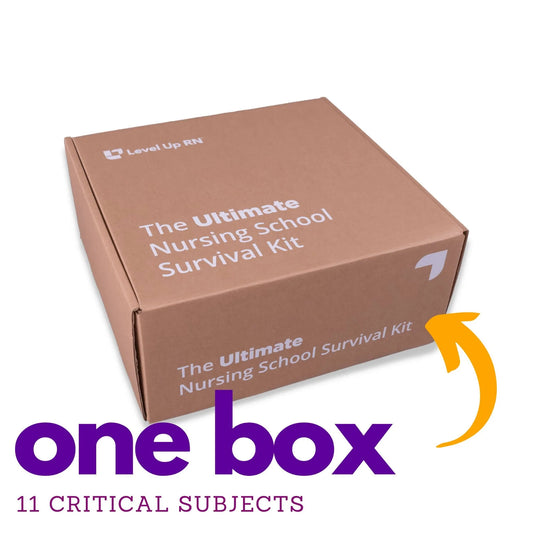Nursing Tips
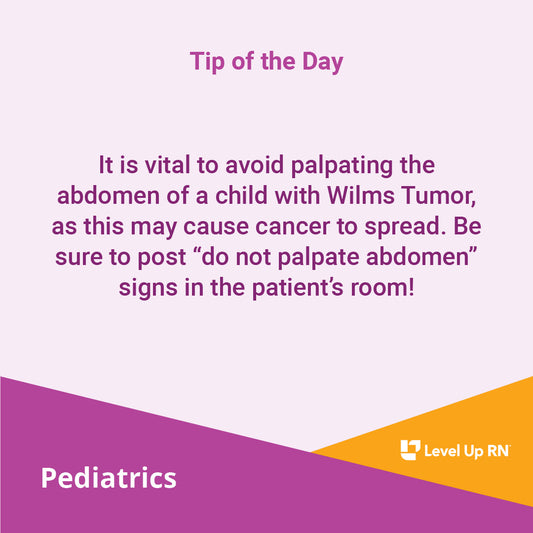
Wilms Tumor - Nursing Care
It is vital to avoid palpating the abdomen of a child with Wilms Tumor, as this may cause cancer to spread.
Wilms Tumor - Nursing Care
It is vital to avoid palpating the abdomen of a child with Wilms Tumor, as this may cause cancer to spread.
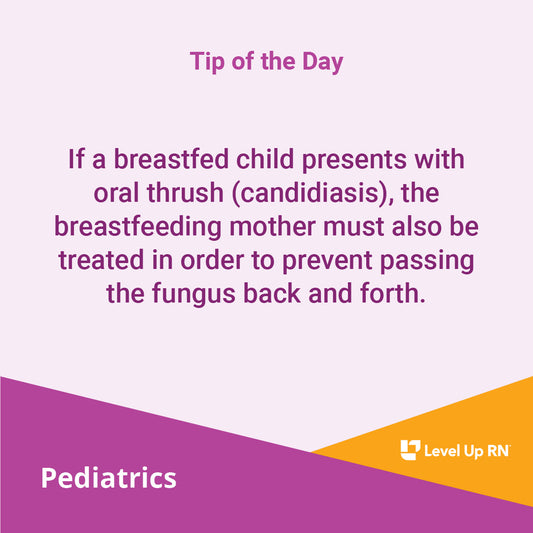
Candidiasis
If a breastfed child presents with oral thrush (candidiasis), the breastfeeding mother must also be treated in order to prevent passing the fungus back and forth.
Candidiasis
If a breastfed child presents with oral thrush (candidiasis), the breastfeeding mother must also be treated in order to prevent passing the fungus back and forth.
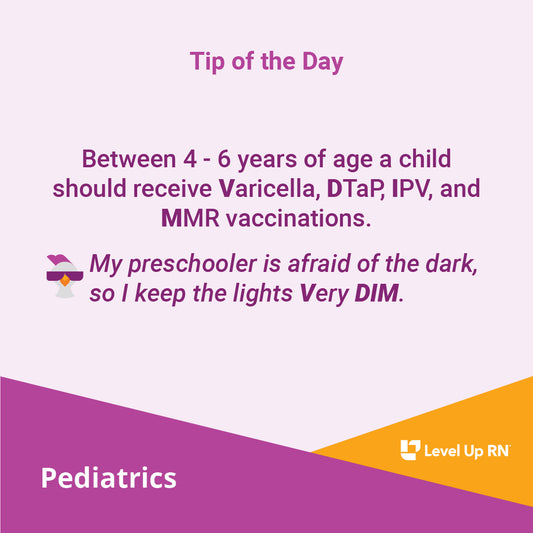
Pediatric Vaccinations
Between 4 - 6 years of age a child should receive Varicella, DTaP, IPV, and MMR vaccinations.
Pediatric Vaccinations
Between 4 - 6 years of age a child should receive Varicella, DTaP, IPV, and MMR vaccinations.
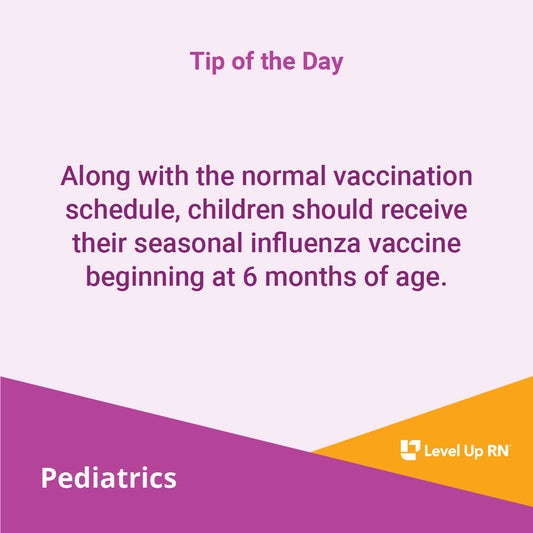
Seasonal Influenza Vaccine
Along with the normal vaccination schedule, children should receive their seasonal influenza vaccine beginning at 6 months of age.
Seasonal Influenza Vaccine
Along with the normal vaccination schedule, children should receive their seasonal influenza vaccine beginning at 6 months of age.
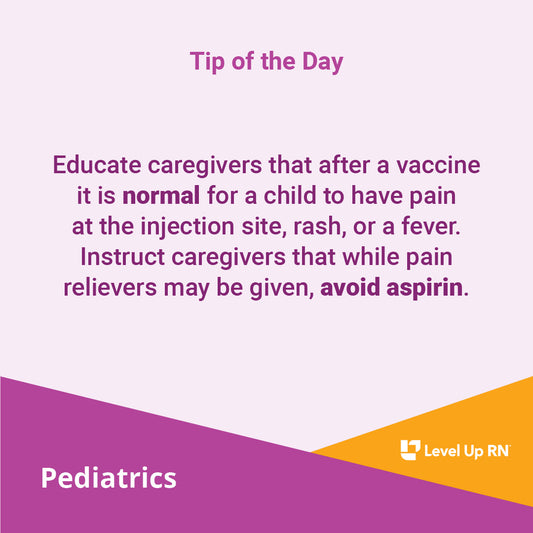
Post-vaccine Care for Children
Educate caregivers that after a vaccine it is normal for a child to have pain at the injection site, rash, or a fever. Instruct caregivers that while pain relievers may...
Post-vaccine Care for Children
Educate caregivers that after a vaccine it is normal for a child to have pain at the injection site, rash, or a fever. Instruct caregivers that while pain relievers may...

Fifth's Disease
Fifth's Disease (Parvovirus-B19) has a classic finding of a "slapped cheek" rash on the face.
Fifth's Disease
Fifth's Disease (Parvovirus-B19) has a classic finding of a "slapped cheek" rash on the face.

Hypospadias and Epispadias
If a child is born with Hypospadias or Epispadias (abnormal placement of the urethral meatus on the penis), circumcision should be delayed, as the foreskin may be needed for reconstructive...
Hypospadias and Epispadias
If a child is born with Hypospadias or Epispadias (abnormal placement of the urethral meatus on the penis), circumcision should be delayed, as the foreskin may be needed for reconstructive...

Hypoplastic Left Heart Syndrome
For Hypoplastic Left Heart Syndrome a surgery in three stages is required: First the Norwood procedure, then the Glenn Shunt, and finally the Fontan procedure.
Hypoplastic Left Heart Syndrome
For Hypoplastic Left Heart Syndrome a surgery in three stages is required: First the Norwood procedure, then the Glenn Shunt, and finally the Fontan procedure.

Failure to Thrive (FTT)
Failure to Thrive (FTT) is indicated by a child's weight being less than the fifth percentile. Assess for both organic causes and parental bonding/care of the child.
Failure to Thrive (FTT)
Failure to Thrive (FTT) is indicated by a child's weight being less than the fifth percentile. Assess for both organic causes and parental bonding/care of the child.

Positional Plagiocephaly
Positional plagiocephaly is cranial asymmetry caused by prolonged pressure on one side of the skull. A child with this diagnosis may require helmet therapy, where a custom-made helmet is worn...
Positional Plagiocephaly
Positional plagiocephaly is cranial asymmetry caused by prolonged pressure on one side of the skull. A child with this diagnosis may require helmet therapy, where a custom-made helmet is worn...
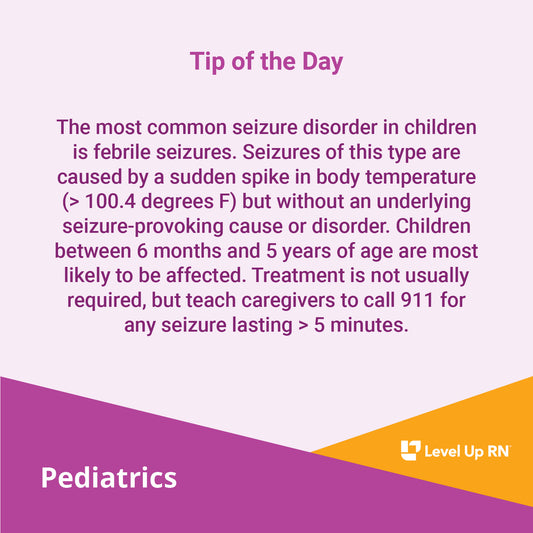
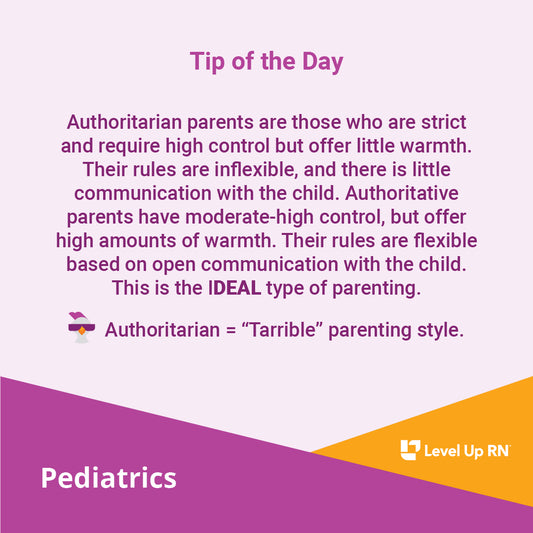
Authoritarian vs. Authoritative Parenting
Authoritarian parents are those who are strict and require high control but offer little warmth. Authoritative parents have moderate-high control, but offer high amounts of warmth.
Authoritarian vs. Authoritative Parenting
Authoritarian parents are those who are strict and require high control but offer little warmth. Authoritative parents have moderate-high control, but offer high amounts of warmth.
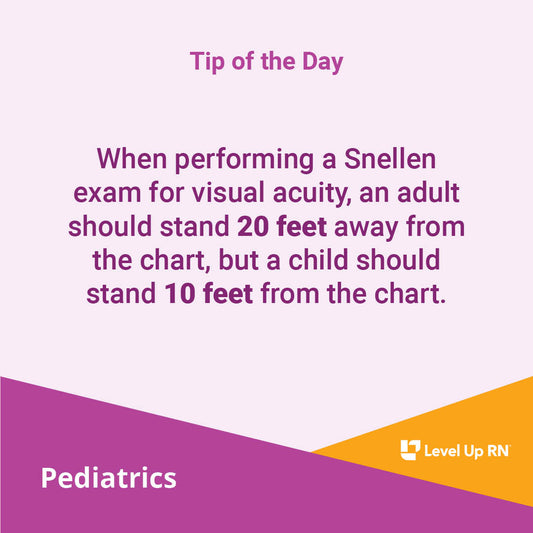
Performing a Snellen Exam
When performing a Snellen exam for visual acuity, an adult should stand 20 feet away from the chart, but a child should stand 10 feet from the chart.
Performing a Snellen Exam
When performing a Snellen exam for visual acuity, an adult should stand 20 feet away from the chart, but a child should stand 10 feet from the chart.

Appendicitis: Family Teaching
When caring for a child with appendicitis, report to the provider any sudden relief of pain. This may indicate that the appendix has perforated and requires emergency surgery!
Appendicitis: Family Teaching
When caring for a child with appendicitis, report to the provider any sudden relief of pain. This may indicate that the appendix has perforated and requires emergency surgery!
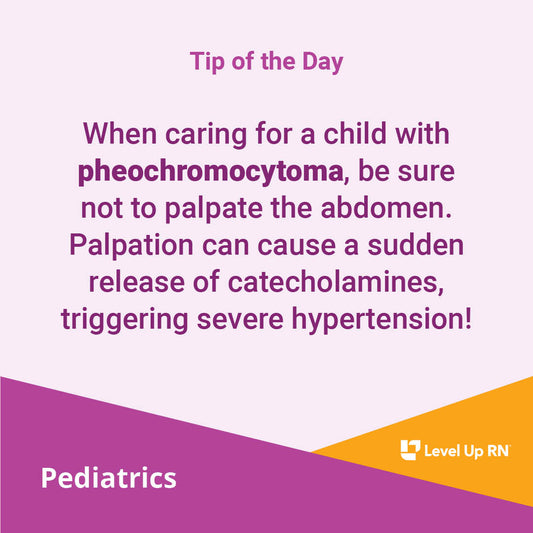
Pheochromocytoma in Children
When caring for a child with pheochromocytoma, be sure not to palpate the abdomen. Palpation can cause a sudden release of catecholamines, triggering severe hypertension!
Pheochromocytoma in Children
When caring for a child with pheochromocytoma, be sure not to palpate the abdomen. Palpation can cause a sudden release of catecholamines, triggering severe hypertension!
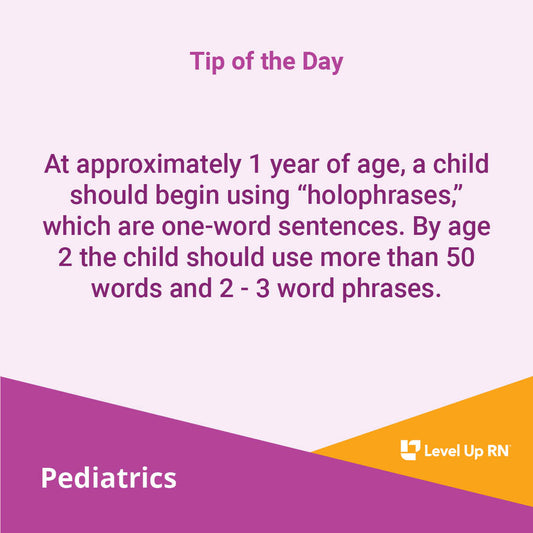
Holophrases
At approximately 1 year of age, a child should begin using "holophrases," which are one-word sentences. By age 2 the child should use more than 50 words and 2 -...
Holophrases
At approximately 1 year of age, a child should begin using "holophrases," which are one-word sentences. By age 2 the child should use more than 50 words and 2 -...
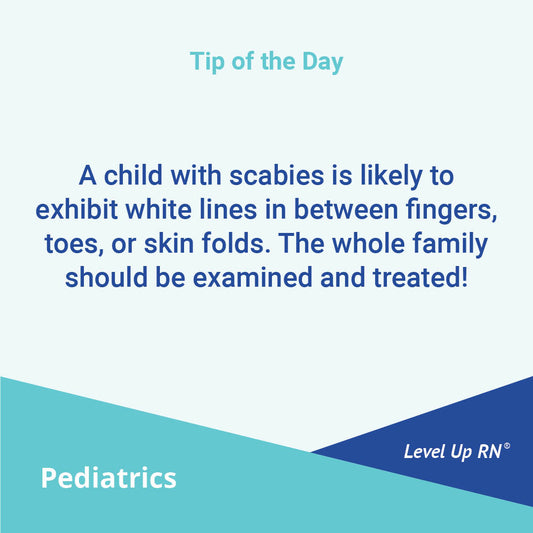
Scabies in Children
A child with scabies is likely to exhibit white lines in between fingers, toes, or skin folds. The whole family should be examined and treated!
Scabies in Children
A child with scabies is likely to exhibit white lines in between fingers, toes, or skin folds. The whole family should be examined and treated!
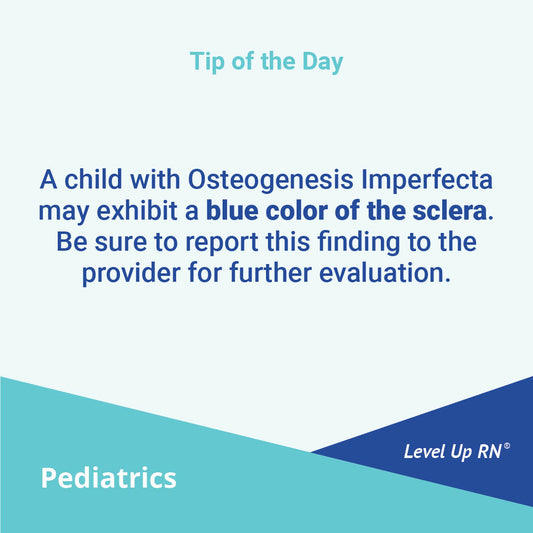
Osteogenesis in Children
A child with Osteogenesis Imperfecta may exhibit a blue color of the sclera. Be sure to report this finding to the provider for further evaluation.
Osteogenesis in Children
A child with Osteogenesis Imperfecta may exhibit a blue color of the sclera. Be sure to report this finding to the provider for further evaluation.
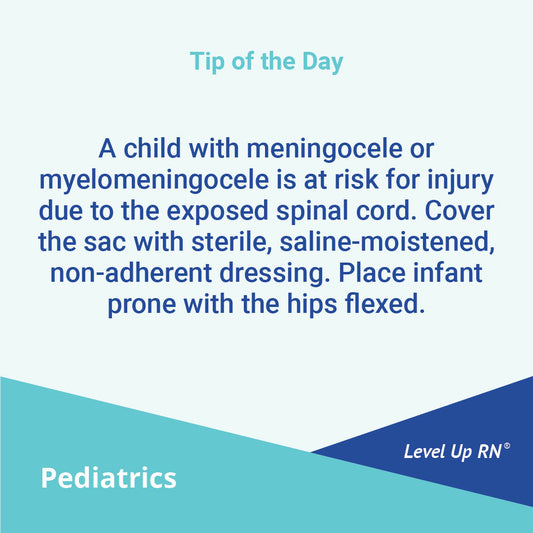
Meningocele and Myelomeningocele in Children
A child with meningocele or myelomeningocele is at risk for injury due to the exposed spinal cord. Cover the sac with sterile, saline-moistened, non-adherent dressing. Place infant prone with the...
Meningocele and Myelomeningocele in Children
A child with meningocele or myelomeningocele is at risk for injury due to the exposed spinal cord. Cover the sac with sterile, saline-moistened, non-adherent dressing. Place infant prone with the...

Meningitis in Children
A child with meningitis is likely to have a fever, headache, nausea, vomiting, irritability, nuchal (neck) rigidity, photophobia, and + Kernig's and Brudzinski's signs.
Meningitis in Children
A child with meningitis is likely to have a fever, headache, nausea, vomiting, irritability, nuchal (neck) rigidity, photophobia, and + Kernig's and Brudzinski's signs.
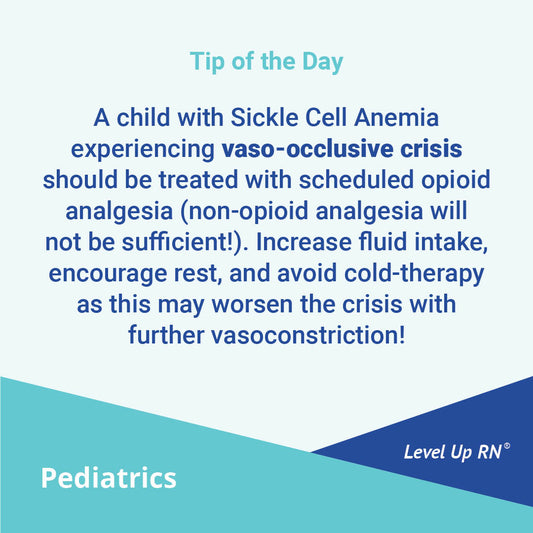
Sick Cell Anemia and Vaso-occlusive Crisis
A child with Sickle Cell Anemia experiencing vaso-occlusive crisis should be treated with scheduled opioid analgesia (non-opioid analgesia will not be sufficient!).
Sick Cell Anemia and Vaso-occlusive Crisis
A child with Sickle Cell Anemia experiencing vaso-occlusive crisis should be treated with scheduled opioid analgesia (non-opioid analgesia will not be sufficient!).
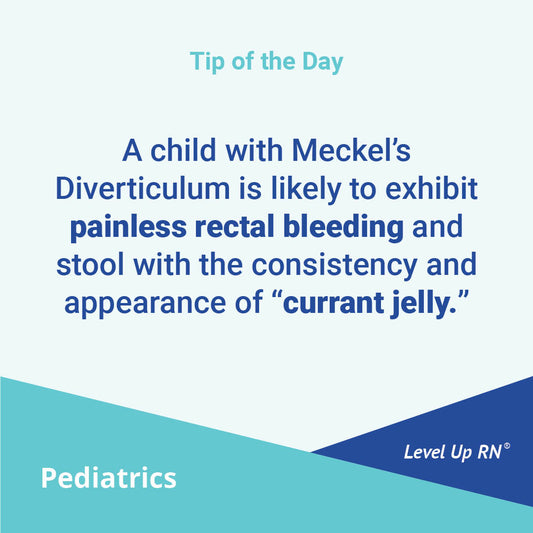
Meckel's Diverticulum
A child with Meckel's Diverticulum is likely to exhibit painless rectal bleeding and stool with the consistency and appearance of "currant jelly."
Meckel's Diverticulum
A child with Meckel's Diverticulum is likely to exhibit painless rectal bleeding and stool with the consistency and appearance of "currant jelly."

Infective Endocarditis in Children
A child with infective endocarditis will require IV antibiotics via PICC line for 2 - 6 weeks, and may require a valve repair or replacement.
Infective Endocarditis in Children
A child with infective endocarditis will require IV antibiotics via PICC line for 2 - 6 weeks, and may require a valve repair or replacement.
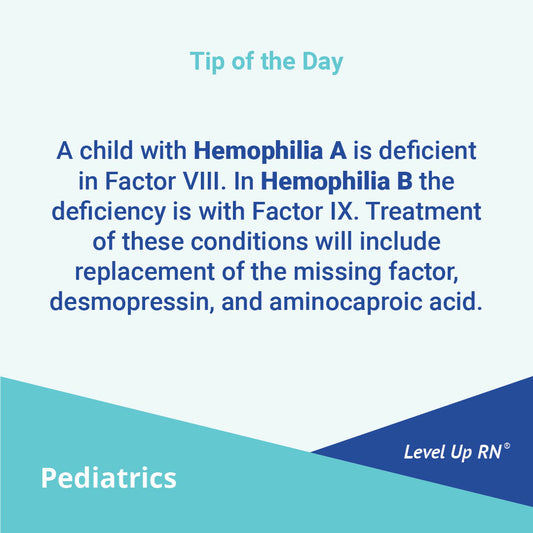
Hemophilia in Children: Signs and Treatment
A child with Hemophilia A is deficient in Factor VIII. In Hemophilia B the deficiency is with Factor IX. Treatment of these conditions will include replacement of the missing factor,...
Hemophilia in Children: Signs and Treatment
A child with Hemophilia A is deficient in Factor VIII. In Hemophilia B the deficiency is with Factor IX. Treatment of these conditions will include replacement of the missing factor,...

Growth Hormone Deficiency
A child with Growth Hormone Deficiency would have an average birth weight/length, but show delayed growth through childhood.
Growth Hormone Deficiency
A child with Growth Hormone Deficiency would have an average birth weight/length, but show delayed growth through childhood.
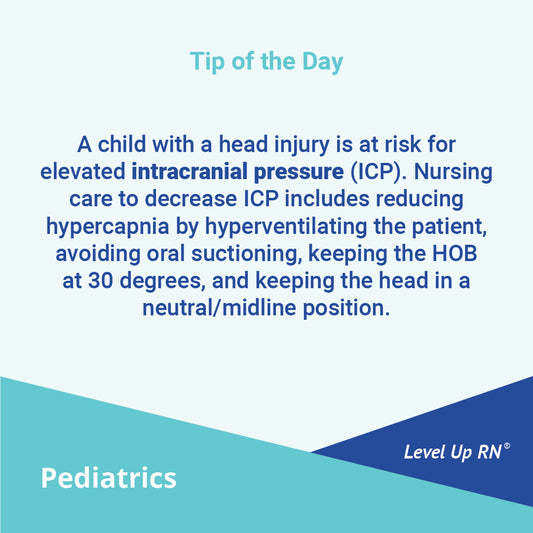
Intracranial Pressure (ICP); Nursing Care
A child with a head injury is at risk for elevated intracranial pressure (ICP). Nursing care to decrease ICP includes reducing hypercapnia by hyperventilating the patient, avoiding oral suctioning, keeping...
Intracranial Pressure (ICP); Nursing Care
A child with a head injury is at risk for elevated intracranial pressure (ICP). Nursing care to decrease ICP includes reducing hypercapnia by hyperventilating the patient, avoiding oral suctioning, keeping...
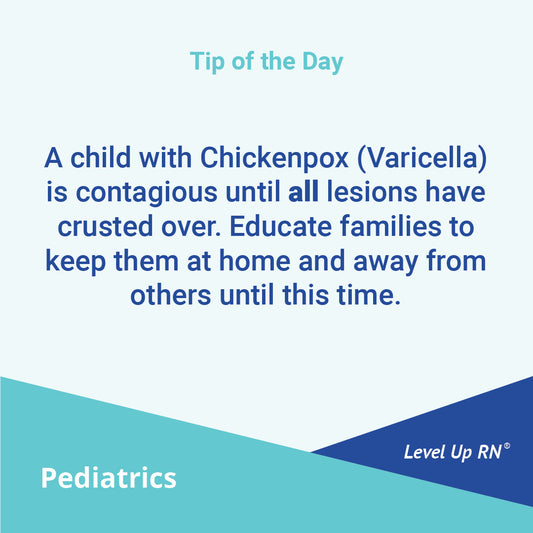
Chickenpox (Varicella)
A child with Chickenpox (Varicella) is contagious until all lesions have crusted over. Educate families to keep them at home and away from others until this time.
Chickenpox (Varicella)
A child with Chickenpox (Varicella) is contagious until all lesions have crusted over. Educate families to keep them at home and away from others until this time.
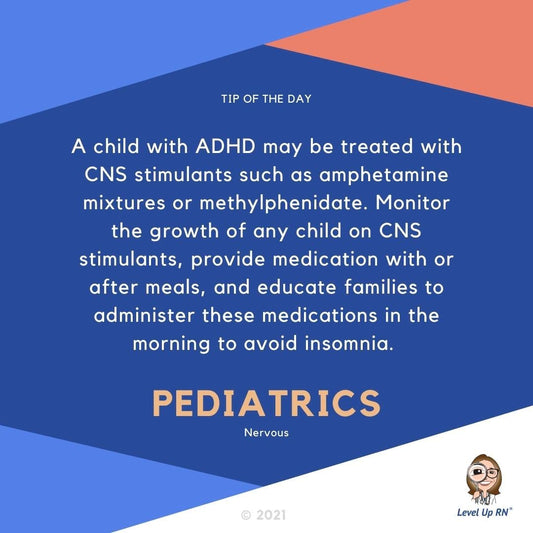
ADHD in Children: Treatment and Nursing Care
A child with ADHD may be treated with CNS stimulants such as amphetamine mixtures or methylphenidate.
ADHD in Children: Treatment and Nursing Care
A child with ADHD may be treated with CNS stimulants such as amphetamine mixtures or methylphenidate.

Spina Bifida Occulta
A child who presents with an abnormal tuft of hair, a dimple, or a birthmark on the spine should be evaluated for spina bifida occulta, a form of spina bifida....
Spina Bifida Occulta
A child who presents with an abnormal tuft of hair, a dimple, or a birthmark on the spine should be evaluated for spina bifida occulta, a form of spina bifida....

Absence Seizures: Signs and Symptoms
A child who appears to be frequently "day dreaming" or often exhibits blank staring, eye fluttering, lip smacking, or picking at clothes should be evaluated for absence seizures.
Absence Seizures: Signs and Symptoms
A child who appears to be frequently "day dreaming" or often exhibits blank staring, eye fluttering, lip smacking, or picking at clothes should be evaluated for absence seizures.

Acute Glomerulonephritis: Signs and Symptoms
A child demonstrating oliguria, cola-colored urine, and signs/symptoms of hypervolemia following a recent streptococcal infection (strep throat) should be evaluated for Acute Glomerulonephritis.
Acute Glomerulonephritis: Signs and Symptoms
A child demonstrating oliguria, cola-colored urine, and signs/symptoms of hypervolemia following a recent streptococcal infection (strep throat) should be evaluated for Acute Glomerulonephritis.
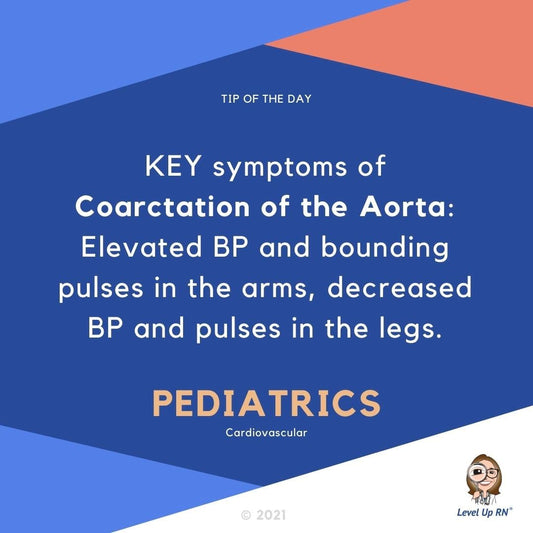
Key Symptoms of Coarctation of the Aorta
KEY symptoms of Coarctation of the Aorta: elevated BP and bounding pulses in the arms, decreased BP and pulses in the legs.
Key Symptoms of Coarctation of the Aorta
KEY symptoms of Coarctation of the Aorta: elevated BP and bounding pulses in the arms, decreased BP and pulses in the legs.
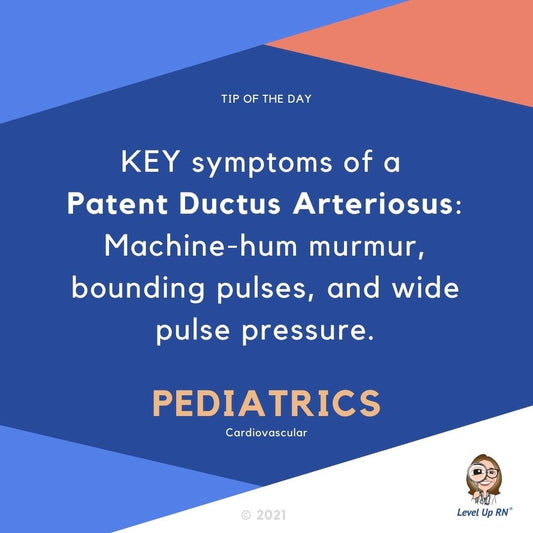
Key Symptoms of a Patent Ductus Arteriosus
KEY symptoms of a Patent Ductus Arteriosus: machine-hum murmur, bounding pulses, and wide pulse pressure.
Key Symptoms of a Patent Ductus Arteriosus
KEY symptoms of a Patent Ductus Arteriosus: machine-hum murmur, bounding pulses, and wide pulse pressure.

Signs and Symptoms of Autism
Key signs/symptoms of Autism: Lack of eye contact Repetitive motions/actions Delayed speech and language skills Strict adherence to routines Unusual eating or sleeping habits Digestive problems.
Signs and Symptoms of Autism
Key signs/symptoms of Autism: Lack of eye contact Repetitive motions/actions Delayed speech and language skills Strict adherence to routines Unusual eating or sleeping habits Digestive problems.

Immunizations in first 6 months
IMMUNIZATIONS IN FIRST 6 MONTHS Birth = "B" Hep B 2 Months = "B. Dr. HIP" Hep B, DTAP, RV, Hib, IPV, PCV 4 months = "Dr. HIP" DTAP, RV,...
Immunizations in first 6 months
IMMUNIZATIONS IN FIRST 6 MONTHS Birth = "B" Hep B 2 Months = "B. Dr. HIP" Hep B, DTAP, RV, Hib, IPV, PCV 4 months = "Dr. HIP" DTAP, RV,...
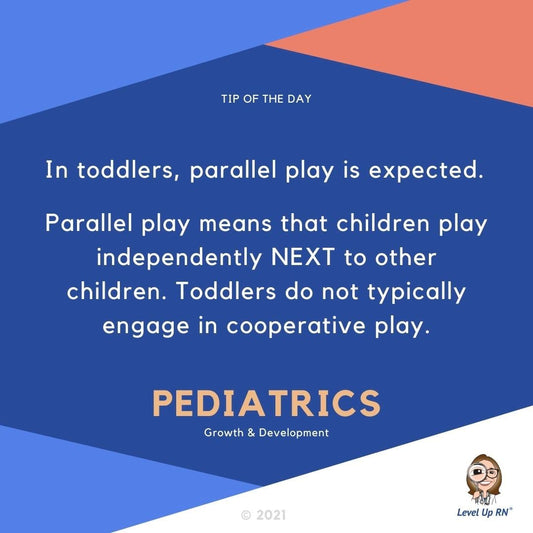
Parallel Play in Children
In toddlers, parallel play is expected. Parallel play means that children play independently NEXT to other children.
Parallel Play in Children
In toddlers, parallel play is expected. Parallel play means that children play independently NEXT to other children.

Severe Dehydration in Children
A child who is crying without producing tears should be evaluated for severe dehydration.
Severe Dehydration in Children
A child who is crying without producing tears should be evaluated for severe dehydration.

Injections for infants
For intramuscular injections under 1 year old, use vastus lateralis muscle!
Injections for infants
For intramuscular injections under 1 year old, use vastus lateralis muscle!
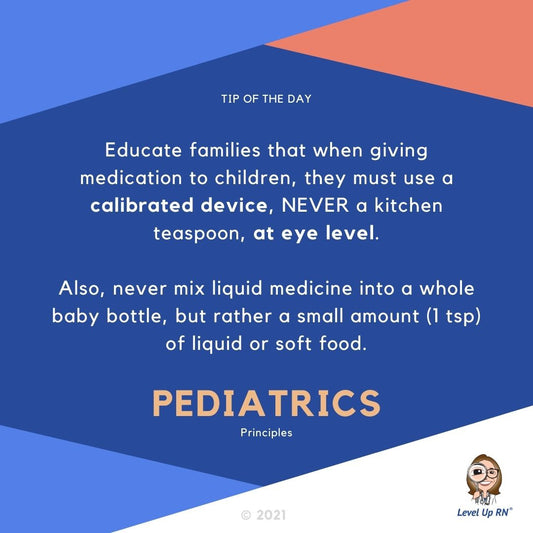
Giving Medication to Children
Educate families that when giving medication to children, they must use a calibrated device
Giving Medication to Children
Educate families that when giving medication to children, they must use a calibrated device

Early Signs of Increased ICP in Infants
Early signs of increased ICP in infants: irritability, high-pitched cry, poor feeding, “setting-sun” phenomenon, bulging fontanels, separation of cranial sutures.
Early Signs of Increased ICP in Infants
Early signs of increased ICP in infants: irritability, high-pitched cry, poor feeding, “setting-sun” phenomenon, bulging fontanels, separation of cranial sutures.

Crib Safety
Crib safety: Infants on back to sleep, nothing in crib, and width of crib slats
Crib Safety
Crib safety: Infants on back to sleep, nothing in crib, and width of crib slats
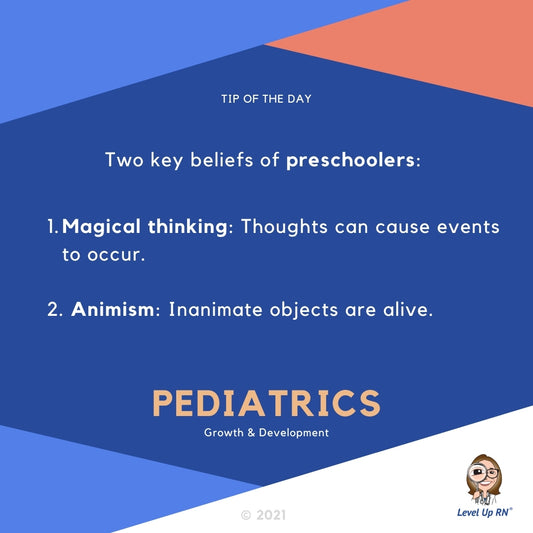
Key Beliefs of Preschoolers
2 Key beliefs of preschoolers: (1) Magical thinking: thoughts can cause events to occur, and (2) Animism: inanimate objects are alive.
Key Beliefs of Preschoolers
2 Key beliefs of preschoolers: (1) Magical thinking: thoughts can cause events to occur, and (2) Animism: inanimate objects are alive.
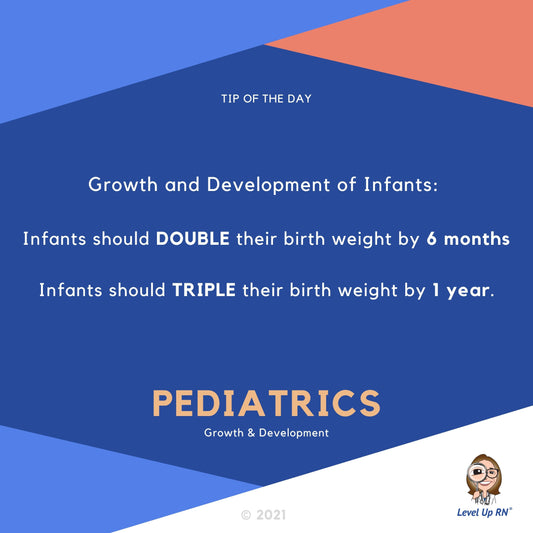
Infant weight gain
Infants should DOUBLE their birthweight by 6 months, and TRIPLE their birthweight by 1 year.
Infant weight gain
Infants should DOUBLE their birthweight by 6 months, and TRIPLE their birthweight by 1 year.
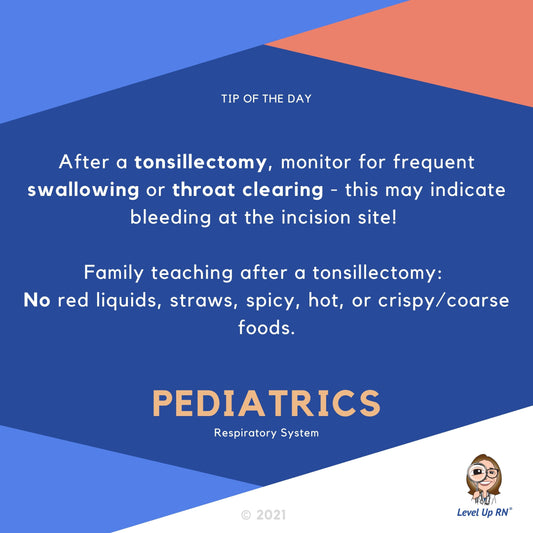
Indications of Bleeding After a Tonsillectomy
After a tonsillectomy, monitor for frequent swallowing or clearing of the throat. This can indicate bleeding at the incision site!
Indications of Bleeding After a Tonsillectomy
After a tonsillectomy, monitor for frequent swallowing or clearing of the throat. This can indicate bleeding at the incision site!

Tooth Eruption
Tooth eruption typically begins around 6 months of age. You can calculate the child's estimated age by the number of teeth they have!
Tooth Eruption
Tooth eruption typically begins around 6 months of age. You can calculate the child's estimated age by the number of teeth they have!

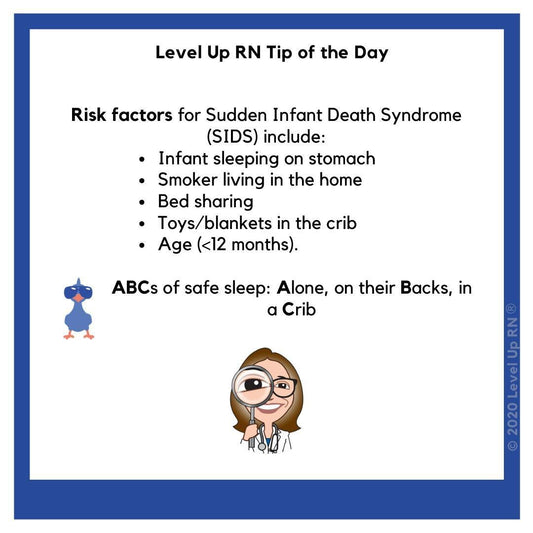
Sudden Infant Death Syndrome (SIDS)
Risk factors for Sudden Infant Death Syndrome (SIDS)
Sudden Infant Death Syndrome (SIDS)
Risk factors for Sudden Infant Death Syndrome (SIDS)

Patent Ductus Arteriosus (PDA)
Patent Ductus Arteriosus (PDA) is a congenital heart defect where the fetal ductus arteriosus fails to close.
Patent Ductus Arteriosus (PDA)
Patent Ductus Arteriosus (PDA) is a congenital heart defect where the fetal ductus arteriosus fails to close.
Filter Articles
Shop
The Ultimate Nursing School Survival Kit - Flashcards
4.869565217 / 5.0
(230) 230 total reviews
Regular price $349.95Regular priceUnit price / per$469.95Sale price $349.95SaleVideos by Subject
Tips & More
Exam Information
Subscribe


